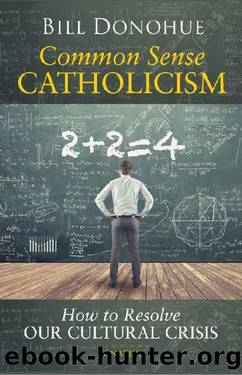Common Sense Catholicism: How to Resolve Our Cultural Crisis by Bill Donohue

Author:Bill Donohue [Donohue, Bill]
Language: eng
Format: epub
Tags: Spiritual & Religion
ISBN: 9781642290660
Publisher: Ignatius Press
Published: 2019-04-12T05:00:00+00:00
The Failure of Progressive Education
Since the first half of the nineteenth century, when Horace Mann looked to the public schools as a natural venue for social reform, egalitarians have seized the schools as one of their favorite sources of experimentation. The mystique of educational reform as the great leveler is a powerful part of American tradition, though the expected results never seem to match expectations. This doesnât stop another round of educational engineering: ideology is not conquered by evidence.
According to an influential study, The Nationâs Report Card, only 37 percent of twelfth-graders, nationwide, were proficient in reading in 2015; 25 percent were proficient in math. For black students, the situation was much worse: 17 percent were proficient in reading, and just 7 percent in math. In some cities, such as Detroit, almost all black students cannot meet standards in reading and math. Nationwide, the average black high school graduate scores at the level of white students in the seventh and eighth grades.35 With data such as these, how can we realistically expect to achieve economic equality?
This is not to say that there are not many excellent public schools across the nationâthere are. Regrettably, there are also many that are a downright disgrace. Why? For reasons that are entirely political, it is next to impossible to terminate teachers who are unqualified or who exhibit serious behavioral problems, or both. But even in middle-tier schools, there are a lot of problems, many of which find their roots in the 1960s.
School achievement did not show signs of decline until the 1960s. In the twenty-year period from the end of World War II to the mid-1960s, SAT scores increased annually, as did other measures of academic performance. What happened to derail this success? Academics with a radical egalitarian bent hit stride in the 1960s, convinced that ânewâ was better. Their experiments were based not on data but on their own untested ideas. It is not hyperbole to say that they nearly destroyed the schools. Administrators who swallowed the moonshine of the intellectuals used children as guinea pigs, setting in motion problems that are still with us.
Charles Silberman was a leading progressive educator during this time. He was not happy with the state of education, noting âwhat grim, joyless places most American schools are, how oppressive and petty are the rules by which they are governedâ. He further condemned teachers for being âobsessedâ with peace and quiet, saying such concerns were âunnaturalâ.36 Educator Jonathan Kozol agreed, charging that the schools were an âintellectual and custodial Hellâ.37
Herbert Kohl agreed with this assessment. He had a laundry list of changes. He urged teachers to do away with the practice of assigning seats to students; school kids should have the right to hang their coats wherever they want; students should not have to raise their hands to ask questions; they should be allowed to line up before class any way they want; talking in class whenever they felt like it should be honored; they should be permitted to chew gum and wear sloppy clothes.
Download
This site does not store any files on its server. We only index and link to content provided by other sites. Please contact the content providers to delete copyright contents if any and email us, we'll remove relevant links or contents immediately.
The Lost Art of Listening by Michael P. Nichols(7169)
Why I Am Not A Calvinist by Dr. Peter S. Ruckman(4048)
The Rosicrucians by Christopher McIntosh(3373)
Wicca: a guide for the solitary practitioner by Scott Cunningham(3045)
Signature in the Cell: DNA and the Evidence for Intelligent Design by Stephen C. Meyer(2879)
Real Sex by Lauren F. Winner(2869)
The Holy Spirit by Billy Graham(2779)
To Light a Sacred Flame by Silver RavenWolf(2679)
The End of Faith by Sam Harris(2637)
The Gnostic Gospels by Pagels Elaine(2400)
Waking Up by Sam Harris(2332)
Nine Parts of Desire by Geraldine Brooks(2282)
Jesus by Paul Johnson(2230)
Devil, The by Almond Philip C(2206)
The God delusion by Richard Dawkins(2191)
Heavens on Earth by Michael Shermer(2190)
Kundalini by Gopi Krishna(2094)
Chosen by God by R. C. Sproul(2056)
The Nature of Consciousness by Rupert Spira(1983)
